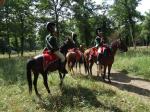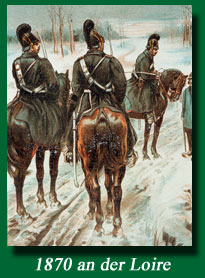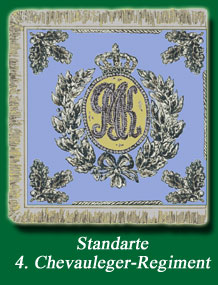1805 Baviere Königlich Bayerisches 4. Chevauleger-Regiment „König“
English Translation
Merci à Christian Adam pour les photographies
Historique Voir ICI
History Click HERE
Königlich Bayerisches 4. Chevauleger-Regiment "König"
La maison de Wittelsbach est une ancienne maison qui remonte au Haut moyen Age mais elle fut longtemps scindée en deux une branche Wittelsbach Palatinat de religion protestante et celle de Bavière catholique . Ce n'est qu'après la mort de Maximilien III . Joseph en 1777 , et avec l’extinction de la branche Bavière que l’électeur Karl Theoder de la ligne de Palatinat - Sulzbach peut unir l’ensemble .
En 1777 née aussi une armée unifiée avec la réunion des armées des deux états
Le 1e septembre 1744 L’électeur Karl Theodor du Palatinat ordonne la reformation de deux régiments de cavalerie à trois escadrons afin de regrouper en une seule force les divers éléments dispersés un peut partout
L'une des deux nouvelles formations , le Reiter-Regiments des Grafen Elliot de Morhange,, incorpore des troupes parvenant du Taxisreiter (Reiter-Regiments "Graf Von Taxis" créée en 1689 et du Karabiniers-Regiment "Graf von Hatzfeld" créée en 1695
Ces troupes sont des cavaliers lourds des cuirassiers qui ont combattus dans toutes les guerres de la fin du XVIIe et de la 1e moitié du XVIIIe( Guerre de Succession d'Espagne contre les Français en 1702 et 1704 à Landau et en 1706, à Turin , Lille 1707 et 1709 à Malplaquet .
Quatre ans seulement après sa constitution comme Reiter-Regiments Elliot Leibregiment ou régiment d’élite servant de gardes de corps aux souverains
Le prince héritier de l'électeur électoral en 1748 était le comte Palatin propriétaire Pfalzgraf Carl August Von Pfalz-Zweibrücken Son successeur en 1751 fut le comte palatin Frédéric Michael Von Pfalz - Zweibrücken , qui devint plus tard le premier roi Maximilian I Joseph de Bavière . L'uniforme du régiment était composé de juste au corps blanches ,avec revers et col rouge pantalon jaune et le tricorne .
L’armée du contingent Palatin fait partie de l'armée impériale durant la guerre de Sept Ans , mais le régiment reste caserné à Heidelberg .
Il faut attendre la bataille de Rossbach le 5 novembre 1757 lorsque Frédéric le Grand, secondé par le général Friedrich Wilhelm von Seydlitz pour voir l’armée Impériale et l’armée française sévèrement battues. Avec cette armée nous trouvons des troupes du Bavaroises ; Se succèdent en 1759 les batailles de Leipzig , Troggau , Meissen et Dippoldswalde, 1760 Strehlen et Wittenberge, 1761 Weida, 1762 Zwickau et Mönchsberg im Gefecht.
En 1777 , nous assistons à la réunion des deux ancienne dynasties suite à l’extinction de la dynastie des Wittelsbach bavarois Les deux maisons sont réunies sous l’égide de l’Electeur du Palatinat Karl Theodor ,
Les régiments bavarois sont incorporés dans la nouvelle armée Kurbayerischen Armee
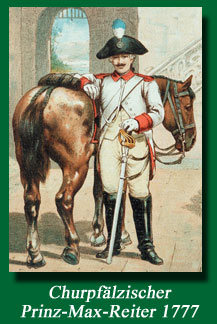 |
Suite aux difficultés financières l’armée subit des coupes drastiques dans ses effectifs et des régiments de cavalerie ont été démontés temporairement
Le 1 janvier 1790 nous trouvons le Kürassier-Regiment Prinz Max le n ° 2 Eine Eskadron réprimer l’insurrection de Liège ,(patriotes de Liège)
Le 6 Février 1799, le régiment est reformé en fournissant comme Herzoglich-Zweibrückenschen Chevauleger-Leibgarde devenant les Chevauleger-Regiment Prinz Luis von Pfalz-Zweibrücken, Par la suite le roi Louis I sera le propriétaire
Le 25 Février 1799 son nom est a nouveau changé en 1. Chevauleger-Regiment Kurfürst Maximilian Joseph. Depuis ce jour, ce régiment sera toujours la propriété de l’électeur qui sera ensuite roi de Bavière le 1 Janvier 1806
Son uniforme se composait d'un habit veste vert à parements rouges et boutons d'argent blanc , culottes grises avec au début casque dit à la Rumford remplacé rapidement par le Raupenhelm .
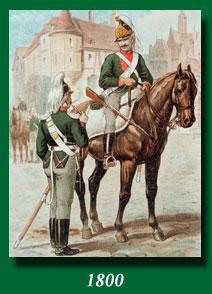 |
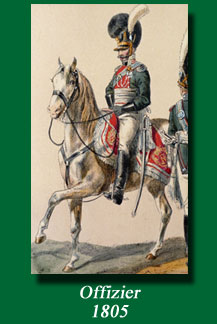 |
Dans la campagne d'Autriche et ses alliés contre la France 1799/1800 le régiment combat à avec 2 escadrons le ??9 Mai 1800 à Bieberach , le 10 Mai à Memmingen et le 27 Juin à Neuburg .
Ensuite il sera engagé lors le ??3 Décembre 1800 à Hohenlinden , à l'est de Munich bataille durant laquelle il s’empare de deux canons et un obusier seuls trophées remportés dans cette bataille par les Allemands .
Les circonstances politiques de 1805 entraine la Bavière dans le sillage de Napoléon dans la guerre contre l'Autriche . Le régiment faisait partie de la Division de Wrede et marcha comme avant-garde Ingolstadt et Munich à Salzbourg .
Durant la guerre contre la Prusse en 1806 et 1807 , le régiment a été déployé sur les instructions de Napoléon en Silésie et en Pologne. Il entre dans Berlin le 30 Juillet 1807
Devenu le 1er Janvier 18062. Chevauleger-Regiment "König", il tient garnison à Augsbourg .
Durant la campagne de 1809, contre l'Autriche , le régiment fait belle figure en combattant dans la division des Leiningen-Chevaulegers de la Brigade du comte Preysing à Straubing ,Landshut contre uhlans autrichiens , a Abensberg , Hausen , Neumarkt an der Rott ,. Ensuite il poursuit les troupes autrichiennes et participe à la bataille de Wagram dans la division Wrede .
Dans la poursuite après cette bataille , elle a perdu son commandant le colonel de Floret .
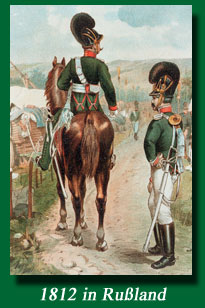 |
Après l'armistice , il s'installe à Linz en Octobre pour lutter contre l’insurrection dans le Tyrol et le 15 Janvier 1810 il est de retour à Augsbourg .
suivent 2 années de paix durant lesquelles , diverses modifications sont apportées dans l'armée bavaroise , avec deux régiments de dragons converties en cavalerie légère . aussi son numéro en 1811, change et devient le numéro 4
Le 17 Février 1812 le régiment est désigné pour participer à la campagne de Russie avec les 3e, 5e et 6 Chevauleger Régiment dans la division sous les ordres du comte Preysing affecté à la Garde Impériale de Napoléon ,
Il participe aux divers engagements sur la rivière Dvina et la Moskova. Durant la retraite il défend les ponts de les Bérézina le 26 Novembre 1812 toujours commandé par le comte Preysing
Les débris du régiment rejoignent Augsbourg en février 1813 sous les ordres du colonel Graf von Seyssel d'Aix .
Quelques semaines plus tard débute la campagne d Allemagne qui voit les troupes bavaroises être pour la dernière fois aux cotés des français par le traité de Ried , le 8 Octobre 1813 la Bavière passe du coté Coalises aux côtés de la Prusse , l'Autriche et la Russie
Son armée est toutefois battue à Hanau par les français ,
Durant la campagne de France en 181 ils combat le 1er Février 1814 à Brienne une attaque et ensuite à Bar et Arcis sur.Aube
Le 1er Avril 1814 il entre dans Paris .
Après le retour de Napoléon de l'île d'Elbe , le régiment a été de nouveau mobilisé mais peu utilisé et le 10 Décembre il regagne sa garnison à Augsbourg
Une période de 15 ans guerre s’achève débute environ 50 ans de temps de paix interrompue en 1832 par l’envoi de troupe en Grèce dans les années 1832-1833 .
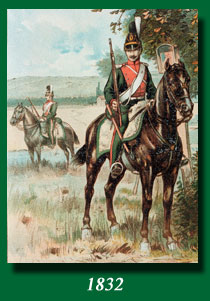 |
En Septembre 1838, le régiment est inspecté en présence de son propriétaire par le tsar Nicolas Ier , le prince héritier de Prusse , l'héritier le Grand-Duc au trône de Russie , le Grand-Duc héritier de Hesse- Darmstadt et le Prince-Édouard de Saxe- Altenburg .
En 1863 a il passe à la 3ème Divisionnouvelle formée avec le 1. Ulanen-Regiments
Dans la campagne de 1866 contre la Prusse , le régiment combat à avec la 2e Division bavaroise
En 1867 est créé un 5e Escadron ,
Durant la guerre de 1870 /71, le 1e escadron passe au 8 Chevauleger Régiment
IL fait partie de la cavalerie divisionnaire attribué au la IIe Division d'infanterie . Son activité principale consistait dans la reconnaissance et le service de patrouille.
Après la guerre, les Chevaulegers restèrent en France jusqu'en 1873 comme force d'occupation Il quitte la France le 4 Août 1873 avec la 3e Régiment d'infanterie pour regagner leurs casernes en temps de paix.
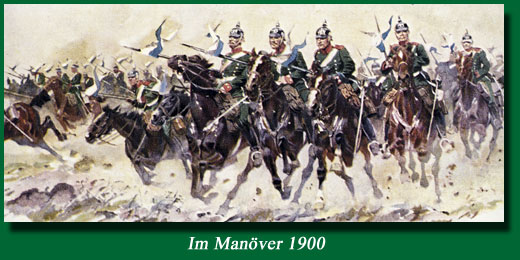 |
Les changements tactiques radicaux intervenus en cette fin du XIXe siècle voient l’introduction de nouvelles armes. Ainsi, la lance en acier tubulaire a été présenté comme arme principale au mépris du sabre par les troupes allemandes. De plus 1909 voit l’introduction du mousqueton 98
Au début de la première Guerre mondiale le 3 Août , le régiment se trouve à Augsbourg Le 3 Mobile eskadron part avec la 3. Infanterie-Brigade den Grenzschutz vers l'ouest vers Saarburg . Le régiment fait toujours parti de la2. bayerischen Infanterie-Division comme pour les autres conflits
Il va au combat avec l’uniforme feldgrau avec bottes brunes
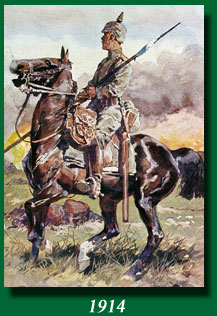 |
Les opérations de harcèlement et commandos vont bon train ainsi l’opération dans la nuit du 23 au 24 Aout 1914 l’escadron des lieutenant von Bomhard et Von Hörmann ,font sauter une ligne de chemin de fer Meurth Switchback près de Menil - Flin ,
Le 22/09/1914 c’est autour de Miraumont que le régiment détruits des générateurs
Mais la guerre de tranchées a fait place à la guerre de mouvement à l’ Ouest aussi les troupes à cheval sont dirigées pour certaines sur le front de l est sur le front de la Carélie
Fin mai 1915 n le 3ème Escadron est assimilé à une troupe de Montagne et devient un Chasseur Alpin à cheval Gebirgskavallerie qui est mis à disposition du Deutschen Alpenkorps, nouvellement créés. Aussi avec l’Edelweiss fixé au chapeau nous trouvons à compter de mai 1915 Königlich Bayerisches 4. Chevauleger-Regiment "König" dans le Tyrol , 1915-1916 , en Serbie , sur les montagnes d'Albanie et de la frontière grecque , 1916,
mais il sera présent dans l'enfer de Verdun , de Douaumont , en Argonne , dans les Carpates en Roumanie à Ploesti en 1917 en Transylvanie , sur l’Isonzo , l et sur le Piave en 1918
Les Chevaulegers seront les dernières troupes après l'effondrement du front en Serbie à quitter ce théatre d’opération avant de passer en Hongrie en état de guerre civile
Quelques éléments sont pris dans la tourmente de la Guerre civile russe qui se déroule en Crimée
Pour pouvoir renter en Allemagne le régiment est contraint de vendre ses chevaux c’ qui sera probablement le moment le plus difficile pour beaucoup de Chevaulegers ; Avoir ou devoir se séparer de cette façon de son cheval
A Noël 1918 et début Janvier 1919 le régiment est rentré dans ces quartiers et sera démobilisé . . En avril se produit divers évènements qui mettent en causes des éléments bolchéviques Aussi des milices Freiwilligen-Eskadron sont levées avec les troupes disponibles afin de lutter contre la terreur bolchevique » bolschewistischen Terrors »à Augsbourg et dans l'Allgäu en mai 1919.
Le 20 Août 1919 le Königlich Bayerisches 4. Chevauleger-Regiment "König est dissous après 113 années d’existence
Ses traditions seront reprises dans la Reichswehr par le 1. Eskadron des (bayerischen) Reiter-Regiment 17 de Bamberg
.
Königlich Bayerisches 4. Chevauleger-Regiment "König"
The House of Wittelsbach ruled the Holy Roman Empire of the German Nation not only Bavaria, but a separate line belonged since the Middle Ages the Palatinate on the Rhine. However, the kinship ties kept the Bavarian Palatinate and the line does not depend on repeated bitter war against each other to lead ; were the Palatinate Wittelsbach but Protestant and Catholic Bavaria . Only after the death of Maximilian III . Joseph in 1777, and the extinction of the Bavarian Wittelsbach became the Palatine Elector Karl Theoder from the line of Palatinate -Sulzbach Elector of Bavaria and united both parts of the country under one rule . Until 1946, when the occupying power, France dissolved the centuries- old connection randomly , then the Palatinate should belong to Bavaria, along the lines of " Bavaria and Pfalz, God receipt ! "
It so happens that some Royal Bavarian regiments look back its origin to a kurpfälzische history , as the armies of the two Wittelsbach electorates were united in 1777 to the Bavarian army . So also the later fourth Chevaulegers Regiment.
On 1 September 1744 ordered the said Wittelsbach Elector Karl Theodor of the Palatinate , the restoration of two cavalry regiments of three squadrons by combining a series of previously scattered dislocated rider associations. One of the two new formations , which received as a regular troops which goes back to the 1689 Taxi Reiter ( Reiter- Regiment " Graf von Taxis " ) and built in 1695 Rifles Regiment " Graf von Hatzfeld " and in 1702 established the Upper Rhenish Circle squadron . All ordinary troops were by their nature cuirassier regiments. The 1689 and 1695 established root regiments were war statements as a result of the Palatine - Orleanschen War of 1688-1697 , which is also referred to as Pfälzischer war of succession , and in the course of the fertile areas of the Rhine Palatinate, and a large part of their irreplaceable cultural buildings (eg Heidelberg and Speyer ) by the in the peaceful country systematically trashed a predatory war sunken French troops of Louis XIV . Subsequently, all three ordinary troops in the War of Spanish Succession were used and fought against the French in 1702 and 1704 in Landau, 1706 in the great victory of Turin, Lille 1707 and 1709 in the famous and costly battle of Malplaquet .
Just four years after the new formation of itself made ??the respective Palatine to " holders " of the regiment and recorded it thus as a kind of "body Regiment" particularly from . The Counts Palatine were in the Palatinate , the electoral prince and heir of the elector . From 1748 was Count Palatine Carl August von Pfalz- Zweibrücken owner , he was succeeded in 1751 Count Palatine Friedrich Michael von Pfalz- Zweibrücken , who later became the first King Max I Joseph of Bavaria . The uniform of the regiment consisted of white skirts , yellow pants, red collars and cuffs , and the three-cornered hat .
As part of the Palatine contingent of the Imperial Army moved two squadrons of the regiment during the Seven Years' War and breadth of Germany , while the body squadron remained in Heidelberg . When Frederick the Great with his famous cavalry general Friedrich Wilhelm von Seydlitz on 5 November 1757 , the French and the imperial army at Rossbach in Thuringia hit devastating , also the Palatinate squadrons were defeated . With great bravery , although without significant achievements they stood in 1759 at Leipzig, Troggau , Meissen and Dippold Walde , 1760 at chasing and Wittenberg , 1761 at Weida, 1762 in Zwickau and monk mountain in combat .
As in 1777 , the Bavarian Wittelsbach dynasty became extinct and the Palatinate was united with Bavaria under Elector Karl Theodor , the regiment came to the Palatinate quota under the new organization will kurbayerischen army. After it had to temporarily leave his horses first significantly reduced for reasons of economy in its troop strength , and even , it was designated Cuirassier Regiment Prince Max and 1 January 1790 , the No. 2 A squadron rode in the same year for Reichsexekutionszug against Liege , stood two months on the Meuse , then took part in the fighting against the " Liège patriots" part and not challenged without flying colors in the meeting of Sudenthal .
On 6 February 1799 , the regiment was re-formed by supplying the dukes Zweibrückenstraße 's Chevauleger Life Guards , featuring a new , lighter horses material and was named Chevauleger Regiment Prince Luis von Pfalz -Zweibrücken , old after his 13 years owner , who later became King Ludwig I. heard the regiment in its history as a cuirassier regiment to battle heavy cavalry , took place with the new formation as Chevauleger Regiment conversion to Light Cavalry. This remained so until the dissolution of the regiment in 1919. With the conversion into light cavalry began the glorious second part of the regimental history , in which the Bavarian Chevaulegers earned himself legendary status .
As early as 25 February 1799 was again the name of the regiment in 1 Chevauleger Regiment Elector Maximilian Joseph changed since the new government came to the father of Prince Ludwig declared himself a regiment . Since that day always the respective sovereign remained owner of the regiment , which is now the name " Elector " and from 1 January 1806 with the collection of the Kingdom of Bavaria , the term "king" was wearing. His uniform consisted of a green Kolett with red facings and white silver buttons , gray breeches and the so-called Rumford Kaskett , which was soon replaced by the high Raupenhelm .
In the campaign of Austria and its allies against France 1799/1800 challenged two squadrons of the regiment on 9 May 1800 at Bieberach , on 10 May at Memmingen and 27 June at Neuburg . The greatest test but had the regiment on 3 December 1800 to put in the so unfortunate for the allied German troops battle of Hohenlinden, east of Munich. The commander of the elector - Chevaulegers , Lieutenant Colonel Freiherr von Dorth , led the Association of Bavarian subsidies Corps 6 squadrons , including the body and colonel squadron against the enemy. The elector - Chevaulegers rode at the head of the Austro- Bavarian Reserve cavalry behind the artillery and baggage of the main column . From Hague through wholesale Hague woods towards Hohen Linden marching it was surprising from the left flank attacked in a forest clearing by a French division. The regimental history has handed down these events in detail :
" Squeezed in the forest, no attack present without possibility to develop, had the allies , powerless as they were, let it happen the encirclement , which you prepared the French under Marshal Moreau . Because , in a moment of dire need , formed lieutenant colonel of Dorth the six squadrons of its combined Chevauleger Regiment in battle position and gave the commanded by Captain Count Seyssel d' Aix colonel squadron command to discard the French skirmishers . Among uninterrupted grapeshot fire of the French established on core firing range batteries and uninterrupted series of fire of the covered behind fences enemy protect led Graf Seyssel the squadron boldly against the enemy, and despite an alarming fluctuation was able to drive back the enemy's skirmishers , with the lieutenant Baron Zandt and Bieber particularly distinguished . Simultaneously, the Leibeskadron fully brought under Captain von La Roche the honorable task of the above take -called enemy battery which had the regiment torn huge gaps , with admirable contempt for death . Two guns and a howitzer were wrested from the French, and there were these the only trophies that have been won in this battle by the Germans. "
The political circumstances of 1805 forced Bavaria to make Napoleon military service in the war against Austria . The regiment was part of the Division Wrede and marched as avant-garde Ingolstadt and Munich to Salzburg. In view of the enemy , swam across the Vorhutschwadron the Salzach river , threw the Austrian vedettes , broke into the city and forced a battalion of infantry and a squadron of hussars to headlong retreat . The regiment marched through Salzburg and Steyer to Bohemia and Moravia and roamed the land in all directions. This gave Lieutenant General von Wrede in German - Budweis Major Anton Graf von Rechenberg- Roth lions that memorable command to clear with a combined Chevauleger squadron against the 18-20 hours away Jihlava abandon outposts and to fill in a surprise attack if possible Jihlava . About this adventurous company regiment reported the Chronicle:
With similar flying colors Chevaulegers led raids on the places Pilgram and Tabor and saved the situation in the meeting at mating, where they had to cover the retreat of Wrede Division against a more than 30 -fold power.
In the years 1806 and 1807, the regiment was deployed on Napoleon's instructions in the war against Prussia at the sideshow in Silesia and Poland. It played a part in the occupation of Glogau , distinguished himself in the battle of chasing on 24 December 1806 and 17 days later at the Battle of Grottkau , took a stroll to the Fortress Neisse , fought successfully in low Hannsdorf , Kanth and Wratha and was involved in the attack on the entrenched camp at the Glatzer jumps, at the intersection of Silver Mountain . About Wroclaw marching, the Chevaulegers place on 30 July 1807 in Berlin.
After 1803 companies Swabian Kreiskürassiere of the Bishopric of Augsburg and a company Swabian circle of dragoons of the imperial city and the county cavalry contingents of the imperial cities of Memmingen , Nördlingen and the rule Mindelheim had already been incorporated , joined in 1807 and the contingent of princes and counts Fugger in the regiment one . Since 1 January 1806 , the regiment led now the name 2 Chevauleger Regiment "King " , on 1 January 1808 it moved into its new garrison Augsburg.
1809 , in the campaign of France and the Confederation of the Rhine against Austria , the regiment was used together with the Leiningen- Chevaulegers in the brigade of Count Preysing . First moved to Straubing , it fought on 15 April in Landshut against Austrian Uhlans , fought at Abensberg , pepper Hausen , Neumarkt an der Rott , took part in the pursuit of the Austrians Salzburg and Ischl , hit honorably in Hellmonsödt in Linz and at the Battle of Wagram in Division Wrede . In pursuit after this battle , it lost its commander Colonel of Floret . In Znaym led General Count von Preysing selbt the king Chevaulegers by Tesch joke about the Taja Bridge and across the river floating - the body squadron ahead - to the successful attack against Hungarian Grenadiers . After the armistice he moved to Linz in October to combat the Tyrolean freedom fighter after Hall. After it had become involved in the storming of Innsbruck and the Isel mountain, it came on 15 January 1810 back to Augsburg
In the following years of peace, various changes were made in the Bavarian army , including the two dragoon regiments were converted into light cavalry . Since 1811 , consequently, led the regiment until its dissolution in the No. 4 because the numbering on the age of the regiments has been introduced.
On 17 February 1812 had the Augsburg site in turn will leave for war against Russia. With the 3rd, 5th and 6 Summarized Chevauleger Regiment to a division under Count Preysing and assigned to the Imperial Guard of Napoleon, swam the Bavarian light cavalry in the face of the enemy the Dvina and fought in numerous battles and engagements , particularly on the Moskva River . In the hasty retreat of the " Grand Army " crossed a small group , the last of a proud division, 26 November 1812 under the Earl Preysing the Berezina River Bridge , 60 torn , ragged officers and King Chevaulegers returned under Colonel Graf von Seyssel d' Aix in February 1813 back to their garrison Augsburg.
But just a few weeks later, recently moved a squadron with the Bavarian Division Raglowich to Saxony and Prussia and battled one last time on the French side . In Bavaria a new army was placed under the General Wrede, which also includes three squadrons King Chevaulegers belonged. The Treaty of Ried , on 8 October 1813 Bayern stepped on the side of the allies , Prussia, Austria and Russia . With a Bavarian-Austrian army attacked Wrede at Hanau on the defeated at Leipzig French, but could not stop them. But successfully attacked here , the regiment French cuirassiers . On 1 February 1814 rode the king and the 5th Leiningen- Chevaulegers again at Brienne an attack. 14 guns and two caissons were their prey. The names of Bar sur Aube and Arcis sur Aube denote the triumph of the regiment. On 1 April moved the King Chevaulegers in Paris. After Napoleon's return from Elba , the regiment was again used in this decision in 1815 and moved on 10 December in his garrison Augsburg again . A war period of 15 years , in which the regiment was eight times drawn to the field, and much founded the legendary reputation of the Bavarian light cavalry had reached its end .
In 1822 two squadrons of the dissolved Lancers than 3 Division - that was the name at that time for a union of two squadrons - queued in the regiment . The 50 -year-long peace operations of the regiment was only interrupted once by the expedition to Greece in the years 1832-33 under the head of the first Squadron , Captain Cook. Again, on the regimental Chronicle reported in a clear way :
In Argos the squadron with Greek and Turkish horses were equipped . Then in November 1833, the relocation of the squadron in the same way to Augsburg , where on 24 January 1834 arrived . On 28 October 1835 was the regiment of King Ludwig I forever the right to use the name Chevauleger Regiment king. On a training camp near Augsburg in September 1838 , the regiment was inspected in the presence of its owner by Tsar Nicholas I , the Crown Prince of Prussia, the Grand Duke heir to the throne of Russia, the Hereditary Grand Duke of Hesse- Darmstadt and the Prince Edward of Saxe- Altenburg. 1863 had the 3rd Division to form the newly built first Lancers are submitted .
Unification wars and up to the First World War
In the campaign of 1866 against Prussia , the regiment moved on 30 MAI Divisional Cavalry Regiment of the 2nd Bavarian Division against Amberg and Lichtenfels , crossed the border and the end of June came on 3 July after Henneberg . After the retreat against Kaltennordheim it took the battle of Kissingen and 26 Part of July to the cavalry attack at the Hett townspeople yards as a reserve and returned at 8 September to Augsburg back .
1867 was a 5th Built Squadron , the 1870/71 as a replacement depot was used and on 10.01.1909 as first Squadron to the newly built 8 Chevauleger Regiment was issued . As 1866 was the king Chevaulegers 1870/71 as divisional cavalry of the second Allocated Infantry Division. Its main activity consisted in reconnaissance and patrol service . After the war, the king Chevaulegers remained until 1873 as an occupation force in France. Only on 4 August 1873 they moved together with the third Infantry Regiment in their peacetime location again .
Drastic tactical changes were made in the time of peace before 1 World War II through the introduction of new weapons. Thus, the tubular steel lance was introduced as the primary edged weapon as with all German cavalry regiments and condemned the saber almost to insignificance . And 1909 was the introduction of the carabiner 98 arming with an excellent firearm , which one was the increasingly important infanteristischem use requirements.
World War I
At the outbreak of the first World War II was born on 2 The evening of August 3 , the mobile Eskadron loaded in Augsburg to 3 with the Infantry Brigade, the border guard west to take Saar castle. Again, as in the past wars, the king Chevaulegers belonged to the existence of the second Bavarian Infantry Division. They moved into the new field gray field uniform with brown boots and leather gear for the first time . It is not possible to enumerate the many patrol rides and riders who deep in enemy territory - the noble perennial East Prussia on the reins and the lance , the queen of the riders arms , in his right hand - have invaded . As an example, we only mention that in the night of 23 24 August 1914 , the lieutenant of Bomhard and Hörmann , have interrupted by blowing up the rail Meurth Switchback near the Menil - Flin , a few hundred meters of an enemy infantry bivouac. Barely a month later, on 09/22/1914 , destroyed lieutenant of Hörmann and Lieutenant Müller from 1 Engineer battalion on a 100 - km ride with 20 Chevaulegers the Miraumont station . Then the onset of trench warfare ended the equestrian activities and also forced the light cavalry in the trenches . Subsequently, the regiment was in the federation of 2 Bavarian Infantry Division as a stage troupe to Poland.
End of May 1915 had the 3rd Excrete squadron of the regiment association , as it is considered "Mountain Cavalry " expected a special use in the newly established German Alpine Corps , the first German mountain troops . With the Edelweiss to the headgear we find from May 1915 King Chevaulegers in Tyrol, 1915-16, in Serbia , on the Albanian mountains and the Greek border , 1916, in the hell of Verdun, at Douaumont , in the Argonne , in the mountain march to the Red - Tower pass in the Carpathians and on the snowy Moskovul saddle , the same year in the glow of the burning oil tanks of Ploesti , 1917 on the Magura Odobesti in Transylvanian Saxons , in the Burgundian gate , the triumph of Tolmain on the Isonzo , the Torrente - Torre- bridge before the destruction of the enemy wrenching , to the Piave in 1918 when the victorious assault on the Mount Kemmel in Flanders , on the retreat battles with Epehy and after the collapse of the Dobropolje in the rearguard in Serbia as one of the last German troops the Sava near Zemun exceed and enter the insurgent Hungary.
After the war, Romania joined in 1916 and the remaining king Chevaulegers could sit again . Together with her old Brigade Regiment from the Napoleonic campaigns , 5 Chevaulegers from Sarreguemines and the Saxon Hussar Regiment No. 18, as they were 3 Cavalry Division on the heights Rotberg in securing lines between the royal Hungarian 51 Honved and K.u.K. 1 Cavalry Division troops pushed . At their bravery crashed on 22 September 1916 , the attack of superior Romanian forces and thus the risk of upsetting the march of 9 Army of General von Falk grove in Transylvania. The commander of the king's Chevaulegers Count of Seyboltstorff interrupted with 4 and 5 Chevaulegers 18 Hussars and K.u.K. Hussars No. 7, the horse artillery - Division No. 15 and the 7th Battery of the Bavarian Reserve - Foot Artillery Regiment 1 in Old Valley the connection between the first and 2 Russian army and was so even in the greatest danger of being crushed decisively in the destruction of the enemy at Hermann village .
No sooner had the victory at Hermann village erfochten , rode the squadrons against the ghost forest. In the Carpathians arrived , had to be served , the usual mountain king Chevaulegers fought like Gebirgsschützen on Spitzberg saddle and stormed the icy 2506 m high La Omu . When the breakthrough was succeeded by the mountains , roared the squadrons of the 4th and 5 Chevaulegers and 18 Hussars of the Association of German - Transylvanian cavalry brigade down to the Wallachian plains . On 6 December 1916 attacked the second Squadron of cavalry captain Renz, followed by the fourth Squadron of Captain von Giese, with a cheer and lance at enemy troops in the village of Petrosani . This tab attack must be described as one of the last attacks in military history . Almost every day brought persecution battles or fights with the who had hurried to the aid of Russian troops until the 20th December, the command of the Supreme Command called off the brigade to the border guards at the Belgian- Dutch border .
In addition to the activities in the border guard service , it was here , the severe mange to master among the horses . Once again brought the railway on 10 September 1917 the squadrons to the East and in the trenches of the Stochod in eastern Poland , on 19 February 1918 was then invaded the Ukraine , while in Munich the oldest active Chevauleger King , Sergeant Kunze of 2 Squadron , based on a 40-year continuous period of service - including 30 years as a sergeant in war and peace - looking back , the regiment owner , King Ludwig III , for the golden wedding conveyed the congratulations of riding against the enemy field regiment. .
By June 1918 2000 kilometers were covered by Stochod unto the Sea of ??Azov . On 11 March was reached Kiev, and on 8 May won the second Squadron as a reconnaissance squadron under Freiherr von gorup as the first German troops against the Bolsheviks a place in Kharkov. From the 10th - 14 June the regiment to repel an attack of 10,000 landed Bolsheviks in Taganrod was used and contributed significantly to crush this dangerous airborne action.
Patrol rides , train destruction , struggles to walk , in the motion , position and mountain warfare , attacks, raids - each fight and usage had brought the four years of war the king Chevaulegers . Only one rule seemed useless to yellow : " The maritime order." But they should come into use . On 1 September , his 175th Foundation Day , the embarkation of the 4th began Chevauleger Regiment in the port of Sevastopol to the Caucasus. Here the regiment broke other German formations from the heights south of Georgia Tbilisi , especially vulnerable German colonists settlements was with Cossack formations to protect against the Bolshevik threat , are used.
After 1 1/2 monthly stay was loaded again and put the regiment through the stormy rough sea to Braila . Thither the collapse of Bulgaria had already thrown its shadow . At higher command schwadronsweise used covered the king and 5 Chevaulegers the return of the troops from Romania by the snowy Carpathian Mountains. The regimental commander , Lieutenant Colonel of landlord , with his adjutant and a few teams , was used as a local commander of Kronstadt between partially decomposed and march incompetent associations and suffered the fate of a long internment. The squadrons rode meanwhile to Cluj . The mass of the horses had to be sold to charter trains for transport to the home can , probably the hardest for a lot of riders to have to separate this way from his horse.
Especially at Christmas met the regiment at home and was demobilized at the beginning of 1919 . While still occurred in April regiment members to form a people's militia and volunteer squadron to fight the Bolshevik terror in Augsburg and in the Allgäu together , from which the Reichswehr squadron was 112 formed in May 1919. On 20 But August 1919 had to leave this last cavalry Augsburg, the fourth the Chevauleger Regiment "King " 113 years long garrison and home was .
After the new formation of the army took over the first Squadron of the ( Bavarian ) Reiter- Regiment 17 in Bamberg , the tradition of King Chevaulegers .
Voir Aussi Autres Photoscopes See Also Others Walk Around
1805 Baviere Chevauleger Epaulette
1805 Baviere Chevaulegers Raupenhelm
1805 Baviere Chevaulegers Giberne






.jpg)
.jpg)
.jpg)
.jpg)
.jpg)
.jpg)
.jpg)
.jpg)
.jpg)
